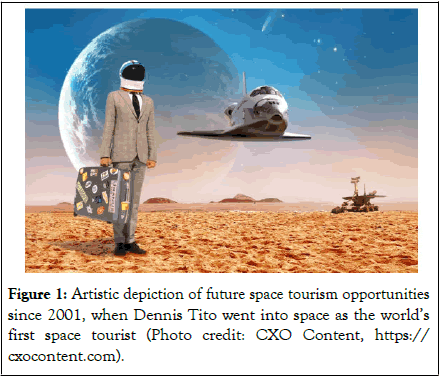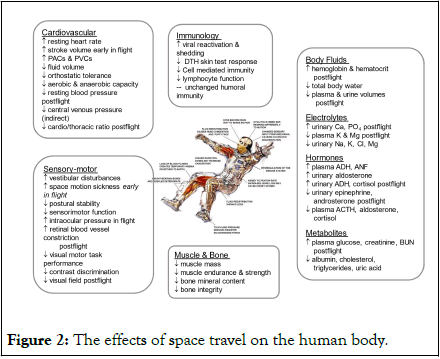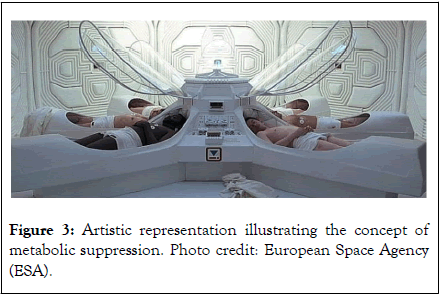Journal of Tourism & Hospitality
Open Access
ISSN: 2167-0269
ISSN: 2167-0269
Mini Review - (2023)Volume 12, Issue 6
Space tourism is no longer a distant dream but a present day reality, with current excursions consisting of suborbital jaunts, and near future excursions to include lunar expeditions and, eventually, trips to Mars. Beneath the allure of weightlessness and cosmic views, however, lies a set of serious health risks for space travelers, including muscle and bone issues, heart problems, and cognitive impairment. In this mini review, we delve into the topic of metabolic suppression, an innovative approach to mitigating the deleterious effects of space travel that has been proposed for astronauts that may be appropriate for space tourists as well. Drawing inspiration from the survival strategies observed in hibernating animals and often depicted in sci-fi narratives where crews are in “suspended animation” throughout most of the voyage, this method involves inducing a reversible state of dormancy, akin to torpor, in human space travelers. The objective of metabolic suppression is to safeguard space travelers from the adverse impacts of extended exposure to microgravity and space radiation on long duration expeditions, so that on arrival at their destination, they can be healthy and ready to go. We shed light on ongoing research endeavors led by the National Aeronautics and Space Administration (NASA), the European Space Agency (ESA), and other prominent organizations dedicated to investing in and advancing metabolic suppression technologies for professional space travel that may also enable space tourism to ever more distant destinations.
Space tourism; Extreme adventure tourism; Metabolic suppression; Torpor; Space medicine; Future space exploration.
In its current stage of development, space tourism is categorized as an expensive and extreme form of “adventure tourism,” characterized by high risks and high costs, which limit access to a select few in the human population. From this vantage point, space tourism provides an exclusive experience, available only for the wealthy and famous, that allows participants to satisfy their human curiosity, feel the rush of adrenaline and, in some cases, receive favorable social publicity. Over time, as costs come down, space tourism will likely become more commonplace, and, indeed, may be a powerful force that helps to drive the commercialization of space travel for a variety of purposes. Space tourism will likely be a critical stepping-stone toward a future in which access to space will be routine.
Currently, science and technology are advancing rapidly and a wider and wider roster of space companies are appearing on the scene, increasing launch capabilities. Gradually, space tourism is becoming more accessible to a broader population. This shift is being propelled by the development of reusable space vehicles and a reduction in the costs associated with launching spacecraft beyond Earth’s gravitational pull. The prospect of affordable space travel may soon become available to a larger segment of society.
The same types of space travel that are pursued by government space agencies are available to space tourists. These include suborbital flights, in which space vehicle occupants experience some degree of weightlessness; orbital flights, in which the space vehicle orbits the Earth for an extended period of time and its occupants experience an extended period of weightlessness; space flights to the Moon, in which space tourists will likely be able to explore the lunar surface, alongside astronauts; and, well in the future, flights to Mars (Figure 1).

Figure 1: Artistic depiction of future space tourism opportunities since 2001, when Dennis Tito went into space as the world’s first space tourist (Photo credit: CXO Content, https://cxocontent.com/).
While passengers on these missions can relish experiences such as weightlessness, the vast darkness of space, the mesmerizing curvature of the Earth, and panoramic views of the Moon while orbiting it, the prospect of space tourism excursions to Mars and other planetary destinations may not be available for decades, because of the associated health risks. Venturing into deep space, beyond the protection of the Earth’s magnetosphere, is considered dangerous, and ensuring safety is of paramount concern for all space travelers [1-3].
While tourists on Earth are familiar with transportation risks (such as car accidents, train mishaps, airline incidents, etc.), as well as various environmental hazards at the destinations (including social, pandemic, crime, and natural disasters), the scenario changes drastically for destinations beyond Low Earth Orbit (LEO), where unprecedented physiological/medical risks are dominant. Even devotees of the most extreme forms of adventure tourism will require that protective measures be taken, so that these extraordinary journeys will be possible.
The high price of space exploration
The cosmic playground isn't just about weightlessness, panoramic views, and moonlit orbits. The captivating visuals transport the viewer into uncharted territories where human physiology faces unprecedented challenges. As the spacecraft ventures Beyond Low Earth Orbit (BLEO), the dangers multiply. When considering the effect of the space environment on astronauts, individual aspects of this environment must be considered, such as launch effects, weightlessness, cosmic radiation, and the effects of long-term confinement. In truth, these specific aspects of the space environment likely act in concert, with possibly synergistic effects in some cases, affecting virtually every aspect of the human body [4-10]. Health risks associated with exposure to the space environment include muscle and bone degeneration, other forms of tissue degeneration, cardiovascular changes, central nervous system effects, risk of cancer development, stem cell depletion, immune system changes, and even cognitive dysfunction (Figure 2).

Figure 2: The effects of space travel on the human body.
As we dream of Martian landscapes, technology to mitigate these health concerns will be necessary so that the human desire for exploration can be enabled.
The journey to Mars is an uncharted trajectory, with health risks casting shadows on the horizon.
Human experience in space is limited. There have been a few human missions to the Moon (Apollo), but there have been neither animal nor human missions beyond the Moon. Thus, there is substantial uncertainty about the actual health dangers that space travelers may encounter on a voyage to Mars.
Despite nearly three decades of space expeditions since Gagarin's pioneering flight, the adaptability of humans to the extraterrestrial realm remains a persistent concern. A growing body of evidence demonstrates that adaptability and survivability in the spaceflight environment could be even more challenging in long-duration space missions beyond LEO than in missions to the International Space Station.
Biomedical studies in space, like the recent NASA biomedical mission involving identical twin astronaut, Scott Kelly, who spent 340 days on the International Space Station, raise serious concerns about the safety of future missions to Mars [10,11].
The tantalizing prospect of the metabolic suppression strategy
Without successful adaptation to the spaceflight environment, future long-duration travel will necessitate innovative life support and life protection systems, or the development of new forms of space transportation. If exposure to the adverse space environment is unavoidable, one approach to mitigating its impact on human physiology would be to minimize or even eliminate the space traveler’s response to spaceflight. In the face of these uncertainties, NASA, ESA and even commercial spaceflight companies are working hard to find solutions. Enter the tantalizing prospect of metabolic suppression, which can be a potential game-changer in these cosmic endeavors. Inspired by the natural survival strategies of hibernating mammals including human-size mammals, such as Arctic bear [12,13], this futuristic concept involves placing humans in a reversible state of torpor, offering a respite from the harsh space environment (Figure 3).

Figure 3: Artistic representation illustrating the concept of metabolic suppression. Photo credit: European Space Agency (ESA).
While deliberately inducing human torpor remains a subject of research, anecdotal reports of individuals surviving unplanned hypometabolic states are worth noting. These include stories of individuals exposed to the extreme cold of landing gear compartments of airplanes, high-altitude mountain accidents such as snow avalanches, and incidents in glacial lakes. These accidental events, combined with scientific investigations of deliberately induced hypometabolic states, unveil intriguing possibilities.
Even a slight suppression of metabolic rate, for example, with cold temperature, could be the key to enhancing survival during spaceflight, addressing multiple challenges simultaneously [14].
The potential benefits extend beyond mere survival the very essence of this strategy lies in its ability to curtail the detrimental effects of prolonged exposure to microgravity and space radiation.
Both government space agencies and private space exploration companies should be highly motivated to develop metabolic stasis as a protection for human space travelers if it can be demonstrated that this approach could mitigate the challenges currently impeding BLEO and planetary missions. NASA and other space agencies have explored this topic. NASA provided substantial support for the initial technological assessment by funding Space Works, Inc., for example, through the NASA Innovative Advanced Concepts (NIAC) program [15]. Another indication of the increasing interest in advancing the metabolic control strategy is the "Space Torpor" workshop held at NASA Ames Research Center in March 2018 [16,17]. NASA's workshop explored recent advances in hibernation biology, metabolic suppression, medical hypothermia, and synthetic torpor. The workshop also showcased the very positive impact that would result if these technical approaches could be implemented, including dramatic reduction in life support resources needed to sustain crew members on deep space missions. The interest in metabolic control strategies extends beyond NASA, with initiatives like the Defense Advanced Research Projects Agency’s (DARPA) Biostasis Program [18] and the European Space Agency's commitment to the "Space Hibernation" technology [19]. These initiatives reflect a common interest in unraveling the mysteries of prolonged space travel and mitigating the associated risks. As we look toward the future envisioning a Mars mission in the 2030s or 2040s the pressing question remains: Is it reasonable to incorporate metabolic suppression into our current spaceflight architecture?
While the lack of proven efficacy poses a challenge, the potential benefits are undeniable. From enhancing space traveler survivability to reducing overall mission costs, metabolic suppression emerges as a tantalizing solution.
Embarking on the extraordinary journey from Earth to Mars demands more than just enthusiasm and excitement; it demands cutting-edge solutions that can redefine the fundamental strategy for protecting space travelers. In the realm of space exploration, where the challenges seem daunting, torpor and metabolic suppression emerge as a must-have game-changing technology that will be pivotal for government space agencies and commercial space enterprises as well. Imagine a future where space tourists, like professional space voyagers, undergo specialized treatments that induce a state of torpor before beginning an extended space journey to an exotic destination in our solar system. Ambitions for space travel by professional astronauts will be enhanced, as well as ambitions for space travel by space tourists. Once the critical science is carried out that allows us to harness metabolic suppression for space travel, we may acquire an important tool for terrestrial medicine too. Metabolic suppression and related technologies may be the key that allows surgeons to perform cardiac surgery with greater protection of cardiac tissue or may be the key that allows organ transplantation to be carried out with greater success. Metabolic suppression may also support other types of extreme exploration, such as undersea exploration to depths that have previously been considered “impossible for humans”.
In this narrative, induced torpor (often called “synthetic torpor”) isn't just a speculative concept; it's a lifeline. Metabolic suppression is a revolutionary technology poised to mitigate the physiological and psychological challenges inherent in prolonged space missions. Picture astronauts and other space travelers—not just as intrepid explorers—but as pioneers, benefiting from the advantages of a torpid state. The most compelling visuals in this forward-looking vision relate to resilience to environmental stressors, be they altered gravity, radiation exposure, or the isolating effects of space travel. This isn't merely a speculative vision. It is a pragmatic solution to the challenges that have long cast shadows on the feasibility of interplanetary exploration.
The collaborative efforts of researchers from multiple space agencies and private enterprise are needed to bring metabolic suppression technology to a mature technology readiness level. A shared commitment will help to make torpor an integral part of the space traveler’s toolkit—a revolutionary approach that transcends the boundaries of traditional space exploration. The text and visuals of this vision convey a compelling story that torpor and metabolic suppression are not just optional “add-ons” but are indispensable components ensuring the success, health, and adaptability of those who dare to travel great distances in space. As we peer into the future, these groundbreaking technologies become the bridge between the dreams of space exploration and the vision of space tourism we hope will become reality.
Funding by NASA Space Biology Program and NASA Human Research Program.
[Cross ref] [Google scholar] [PubMed]
[Cross ref] [Google scholar] [PubMed]
[Cross ref] [Google scholar] [PubMed]
[Cross ref] [Google scholar] [PubMed]
[Cross ref] [Google scholar] [PubMed]
[Cross ref] [Google scholar] [PubMed]
[Cross ref] [Google scholar] [PubMed]
[Cross ref] [Google scholar] [PubMed]
[Cross ref] [Google scholar] [PubMed]
[Cross ref] [Google scholar] [PubMed]
Citation: Griko Y, Loftus D, Stolc V (2024) Metabolic Suppression: A Promising Solution to Unlock the Future of Space Travel. 12:537.
Received: 18-Dec-2023, Manuscript No. JTH-23-28533; Editor assigned: 21-Dec-2023, Pre QC No. JTH-23-28533 (PQ); Reviewed: 04-Jan-2024, QC No. JTH-23-28533; Revised: 11-Jan-2024, Manuscript No. JTH-23-28533 (R); Published: 18-Jan-2024 , DOI: 10.35248/2167-0269.24.12.537
Copyright: © 2024 Griko Y, et al. This is an open-access article distributed under the terms of the Creative Commons Attribution License, which permits unrestricted use, distribution, and reproduction in any medium, provided the original author and source are credited.